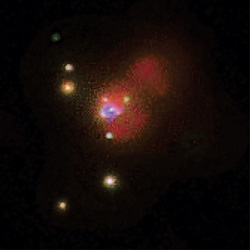May 14, 2001
CXC PR: 01-07
Probing a large, nearby galaxy in the constellation of Circinus, NASA’s Chandra X-ray Observatory presents a new view of both the galaxy’s supermassive black hole and a host of potential smaller black holes sprinkled throughout its spiral arms. The results include the first detection of a black hole’s periodic variability in X-rays outside our galactic neighborhood.
Astronomers from Penn State University used Chandra to discover a variable object within the dozen or so X-ray emitting sources sprinkled throughout the Circinus galaxy. The intensity of X-rays from this source changes on a cycle of 7.5 hours – the first time this "periodic variability" has been detected at X-ray wavelengths in an object outside the "Local Group" of galaxies. And, along with its brightness, this evidence strongly suggests that the system contains a black hole some 50 times the mass of the Sun.
"Extremely luminous X-ray sources such as this one appear to be common among other galaxies," said Franz Bauer, a postdoctoral scholar at Penn State and lead author of a July 2001 paper in The Astronomical Journal. "But until Chandra, we have never had an instrument that could clearly identify whether they were simply massive X-ray binary systems, or if they represented a new class of objects"
"The periodic variability in the Chandra data of Circinus provides us with a key signature that these objects are indeed X-ray binary systems," continued Bauer. "This is important because black holes with masses much larger than 10 times the mass of the Sun such as this one are difficult to explain under current theories of star formation and destruction. Definitively finding a periodic signal in one allows us to test some of our past assumptions."
The X-ray data acquired by two independent teams -- one at Penn State and George Mason University and the other at the University of Maryland -- also provide evidence that strongly supports the "unified model," a theory in which a large doughnut-shaped ring is thought to obscure the central black hole.
In the case of Circinus, this ring of material obscures a direct line of sight to the central black hole. Its existence is inferred from a detailed analysis of the gas distribution and physical conditions near the center of the galaxy by the two teams. At least two different gas components are identified near the nucleus. One, a warm gas that is heated and ionized by the radiation field from the black hole, contains strong emissions of highly ionized elements such as argon, calcium, iron, magnesium, neon, silicon, and sulfur. The second gas component is cooler and features a strong iron emission line. In addition, the astronomers were able to show that the two gas components have different distributions, with the warmer gas being spread over a much larger region around the black hole than the cooler gas.
"The Chandra observations of Circinus show us how complex the gaseous environment of supermassive black holes can be," said Rita Sambruna, assistant professor of physics and astronomy at George Mason University. "Because it is close and thus easy to study, Circinus provides an important testbed for what might be happening in other, more distant so-called active galaxies."
The Chandra images allowed the astronomers to determine that the X-ray emission associated with the central black hole can be resolved into a number of distinct components. A bright, compact emission source is present at the center of the image, and that nuclear source is surrounded by a diffuse X-ray halo that extends out several hundred light years. The researchers also detected a cone of hot gas extending out from the galaxy's core to a distance of 2000 light years to the northwest.
"The large region of X-ray emitting gas extending out of the galaxy disk looks very similar to the gas seen in optical observations," said David Smith, research associate at the University of Maryland. "This may imply the X-ray gas is heated by material close to the galaxy's supermassive black hole."
On astronomical scales, this galaxy is considered quite close, a mere13 million light years from Earth. Since it’s located near the plane of our own Milky Way Galaxy, the Circinus galaxy is partially hidden by intervening dust along our line of sight. As a result, the galaxy went unnoticed until about 25 years ago.
Along with Sambruna and Bauer, the first research group included Hagai Netzer of Tel-Aviv University and the following collaborators from Penn State: Niel Brandt, George Chartas, Gordon Garmire, John Nousek, and Shai Kaspi. The University of Maryland team also included Andrew Wilson. The results of theses Chandra observations appear in recent and upcoming papers in The Astrophysical and Astronomical Journals.
Observations with Chandra, using the Advanced CCD Imaging Spectrometer (ACIS) and the High Energy Transmission Grating Spectrometer (HETGS), were made on June 6-7, 2000 and observations without the HETGS were made on March 14, 2000.
The HETG and ACIS instruments were built for NASA by the Massachusetts Institute of Technology, Cambridge, MA, and Pennsylvania State University, University Park. NASA's Marshall Space Flight Center, Huntsville, AL, manages the Chandra program for the Office of Space Science, Washington, DC. TRW, Inc., Redondo Beach, California, is the prime contractor for the spacecraft. The Smithsonian's Chandra X-ray Center controls science and flight operations from Cambridge, MA.
Images associated with this release are available on the World Wide Web at:
MEDIA CONTACTS
Steve Sampsell
Penn State, University Park, PA
Phone: 814-865-1390
sws102@psu.edu
Steve Roy
Marshall Space Flight Center, Huntsville, AL
Phone: 256-544-6535
Megan Watzke
Chandra X-ray Observatory Center, CfA, Cambridge, MA
Phone: 617-496-7998



